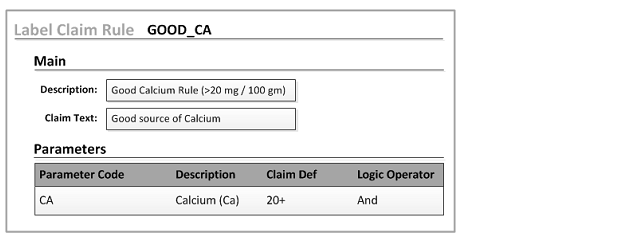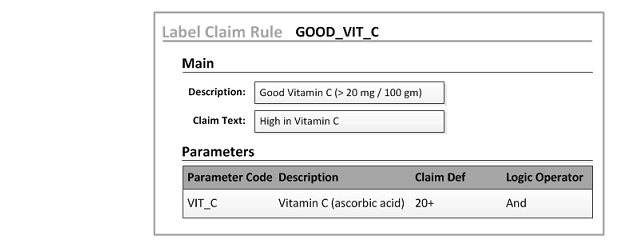Components of a label claim
Nutritional and non-nutritional claims are constructed the same way.
Each label claim is composed of at least one claim rule. For example, the FDA
Claim can be composed of only the
GOOD_CA rule. Or, it can be composed of a collection of
rules, such as
GOOD_CA and
GOOD_VIT_C.
Each rule associates the parameter code(s) with the claim definition logic.

The claim definition logic can be constructed to be used with parameter codes for Items, Formulas, Specifications, and Analysis objects or any combination thereof.
Here is an example of how the 20+ Claim Definition could be constructed:
Parameter value on an Item or Formula must be greater than or equal to 20.
OR
Minimum target parameter value on a Specification must be greater than 20 and less than 70.
OR
Recommended value on an Analysis object must be less than 80.
In this example, the GOOD_CA rule uses the
CA parameter and the GOOD_VIT_C rule uses the VIT_C parameter.
Both the GOOD_CA and GOOD_VIT_C rules reference the
same claim definition logic.
This logic determines whether the claim text, on the corresponding rule(s), is applied to the Label Content object.


What happens when you apply the FDA Claim to the Label Content object? The rule logic is compared to the source values that are defined in the Label Content object.
Suppose you defined a formula on the Label Content object. Then, the formula parameter value is compared to the parameter value that is defined for the rule.
If the rule passes, the label claim text is displayed in the Label Content object.
If it fails, the label claim text is not displayed.
If a claim has a collection of rules assigned to it, it is also possible
for some rules to pass and some rules to fail. For example, if only the
GOOD_CA rule passes, then only the claim text for that
rule is displayed in the Label Content object.
